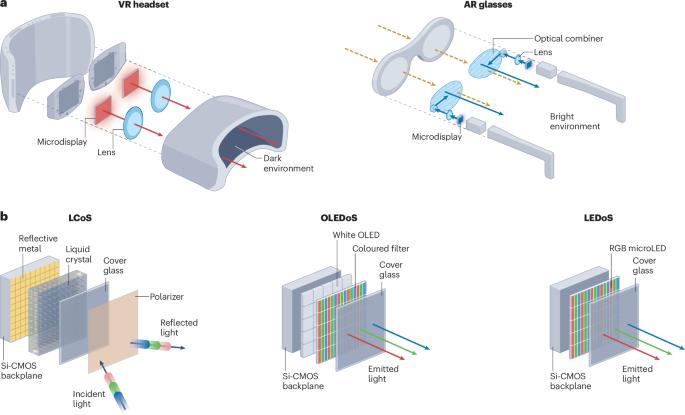Microdisplay technologies in augmented reality and virtual reality headsets
引用次数: 0
Abstract
Augmented reality (AR) and virtual reality (VR) technologies enable interactive and immersive user experiences through head-worn devices that contain microdisplays. These microdisplays must have superior pixel density, brightness, contrast and response times, owing to the proximity of the AR glasses or VR headset to the eyes. Advanced microdisplay technologies in light engines such as liquid crystal on silicon (LCoS), organic light-emitting diodes on silicon (OLEDoS) and light-emitting diodes on silicon (LEDoS) have emerged to meet the demands of AR and VR, and are typically integrated with optical components such as free-space, freeform or waveguide combiners. In this Perspective, we explore the key requirements for AR and VR microdisplays, consider the advantages of each light-engine technology and discuss how their performance can be accurately characterized. We also examine how LCoS, OLEDoS and LEDoS technologies are integrated with complementary metal–oxide–semiconductor (CMOS) backplanes, and paired with optical combiners in AR displays, to merge virtual images with real-world scenes. Microdisplays for the glasses and headsets used in augmented reality and virtual reality must provide high pixel density, brightness and contrast, and fast response times. This Perspective explores three advanced technologies — liquid crystal on silicon, organic light-emitting diodes on silicon, and light-emitting diodes on silicon — that can meet the challenge.

增强现实和虚拟现实耳机中的微显示技术
增强现实(AR)和虚拟现实(VR)技术通过包含微显示器的头戴式设备实现交互式和沉浸式用户体验。这些微型显示器必须具有优越的像素密度、亮度、对比度和响应时间,因为AR眼镜或VR耳机离眼睛很近。为了满足AR和VR的需求,诸如硅基液晶(LCoS)、硅基有机发光二极管(oldos)和硅基发光二极管(LEDoS)等光引擎中的先进微显示技术已经出现,并且通常与自由空间、自由形式或波导合成器等光学元件集成。在本展望中,我们探讨了AR和VR微显示器的关键要求,考虑了每种光引擎技术的优势,并讨论了如何准确表征它们的性能。我们还研究了LCoS、oledo和ledo技术如何与互补金属氧化物半导体(CMOS)背板集成,并与AR显示器中的光学合并器配对,以将虚拟图像与现实场景合并。用于增强现实和虚拟现实的眼镜和耳机的微显示器必须提供高像素密度,亮度和对比度以及快速响应时间。本展望探讨了三种先进技术——硅基液晶、硅基有机发光二极管和硅基发光二极管——可以应对这一挑战。
本文章由计算机程序翻译,如有差异,请以英文原文为准。
求助全文
约1分钟内获得全文
求助全文

 求助内容:
求助内容: 应助结果提醒方式:
应助结果提醒方式:


